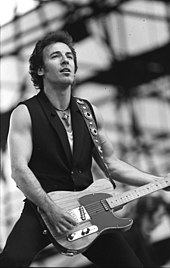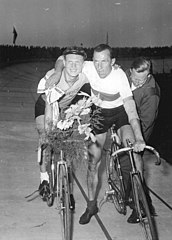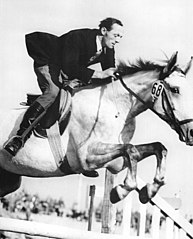Weissensee Velodrome
| Weissensee Velodrome | |
|---|---|

|
|
| Opening ceremony on September 25, 1955 | |
| Data | |
| place | |
| Coordinates | 52 ° 33 '52.1 " N , 13 ° 27' 27.7" E |
| operator | Magistrate Berlin |
| opening | 1955 |


The Weißensee Radrennbahn describes a large cycling track in Berlin-Weißensee and its surrounding area. According to the classic standard, the circular course of the railway was 333 m and was made of concrete. The entire area was much larger.
Cycle races and harness races
The cycling track was built in 1954/1955 on the site of the former Weißensee trotting track and equipped with stands for 9,000 spectators using rubble. The construction of the facility was supported by 6,000 construction workers. It was used as a venue for sports competitions (such as the "Berlin Railway Championship", "Great Easter Prize", "Goldenes Rad von Berlin", GDR championships in track cycling etc.) with racing bikes , motocross machines or trial bikes . The inauguration of the railway took place on September 25, 1955 in front of 8,000 spectators. For the inauguration, well-known former cyclists such as Oskar Michael , Willy Kutschbach , Oskar Tietz and Willi Funda drove a lap of honor. The first race, a two-man team , was won by Werner Malitz and Heinz Wahl .
From 1962, after a 20-year break, riding and jumping tournaments were held on the site again. The velodrome Weissensee was at the since 1878 after the former harness racing track named Rennbahnstraße .
- Photo gallery
DRSV President Werner Scharch (r.) Honors the winners in the two-man team driving of the youth, 1956
Use for music festivals and concerts
From the late 1980s, the grounds of the Weißensee Radrennbahn were used for major music events and open-air festivals lasting several days . Joe Cocker performed here on June 1, 1988, and from June 16 to 19, 1988 the largest rock festival in the GDR took place here under the name "Peace Week of Berlin Youth". There were u. a. The Wailers , James Brown , Fischer-Z , Rainbirds , Bots , Big Country , Marillion and GDR bands like City and Die Zöllner ; Katarina Witt and her later manager Diether Dehm moderated. On the occasion of the 25th anniversary, Radio Eins dedicated itself on October 3, 2013 with a 12-hour special program Der Sommer 1988 to this unique music summer for young people in the GDR .
A little later, on July 19, 1988, the American rock musician Bruce Springsteen gave the biggest solo concert in GDR history with the E-Street band during the Tunnel of Love tour, with 160,000 officially sold tickets at 20 marks each GDR. In real terms, there were probably 200,000-300,000 visitors because the onslaught of the masses surrendered the security forces and the paths were free. That was 2.5 percent of all adult GDR citizens. Fans from all over the country hitchhiked to the concert or came by train and car.
It was also Springsteen's biggest live performance and was based not least on his desire to play "on the other side" for once. It was officially named by the organizer as a “Concert for Nicaragua ”. Springsteen said the famous phrase to the audience:
“It's good to be in East Berlin. I am not here for or against any government. I came to play rock'n'roll for you, East Berliners, in the hope that one day all barriers will be knocked down. "
On August 22, 1989, eight German musicians, including Ulla Meinecke and Heinz-Rudolf Kunze , performed with accompanying bands on the cycling track. The performance marked the end of the rock poet tour that had led through the GDR. The concert had around 120,000 visitors and was broadcast live by ARD .
After the Berlin Wall opened on November 9, 1989, the Rolling Stones performed as part of their Urban Jungle Tour on August 13 and 14, 1990 at the Radrennbahn in Weißensee - these were the only concerts in Germany that featured the impressive Steel Wheels stage of the US tour, which had been flown in from the USA especially for this purpose, were organized. Due to the significantly higher admission price and increased security measures, audience numbers like Springsteen could not be achieved.
Todays use
In the late 1990s, the circuit and the grandstands of the cycling track were demolished. Today there are two "Roadrunners Berlin" baseball fields, a soccer field and an athletics track behind a rusty iron fence on the former cycling track .
literature
- Erik Kirschbaum: Rocking the wall. Bruce Springsteen in East Berlin 1988 - The legendary concert . Verlag Berlinica, New York City, USA 2013, ISBN 978-1-935902-77-5 (in German); English: ISBN 978-1-935902-75-1 .
See also
- List of cycle tracks in Berlin
- on to the summer of music in 1988 : concerts in the Werner-Seelenbinder-Halle in 1988
Web links
- Biggest rock festival in the GDR from June 16-19, 1988 on the Weißensee Radrennbahn
- Photos, documents, quotes + video of Bruce Springsteen's concert on July 19, 1988 on the Velodrome
References and comments
- ^ Presidium of the Cycling Section of the GDR (Ed.): Cycling Week . No. 40/1955 . Sportverlag, Berlin, p. 3 .
- ↑ Friedenswoche 1988 at concertarchiv.net, accessed on December 18, 2019
- ↑ Radioday on October 3, 2013, "When the Wall rocked in Berlin" ( Memento from December 2, 2013 in the Internet Archive ) on radioeins.de from October 3, 2013 (archive version)
- ↑ "Mein Sommer '88" , on mdr.de, accessed on December 16, 2018
- ↑ Bruce Springsteen in the GDR, "Scream for Freedom" , in Mitteldeutsche Zeitung from July 5, 2013
- ↑ Born in the DDR on zeit.de from July 29, 1988
- ↑ Andreas Braun: Heinz-Rudolf Kunze in Bernburg Castle: A portrait for "25 years of German unity". mz.de from November 8, 2015, accessed on December 16, 2018
- ↑ Rock faded away, the fine arts remained. In: Der Tagesspiegel November 27, 2007
- ↑ Only the rusty fence is reminiscent of the Berlin-Weißensee bicycle race track . In: Mitteldeutsche Zeitung from July 19, 2013
- ^ In July, before it started, in Frankfurter Allgemeine Sonntagszeitung on July 21, 2013, page 38





